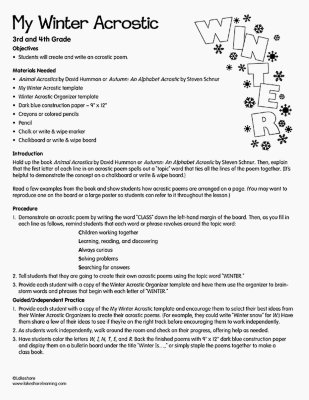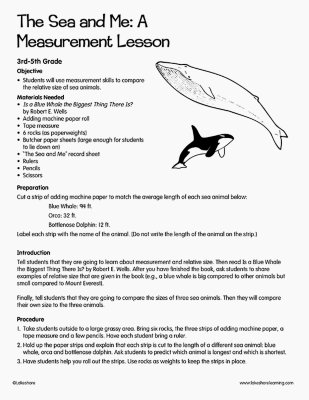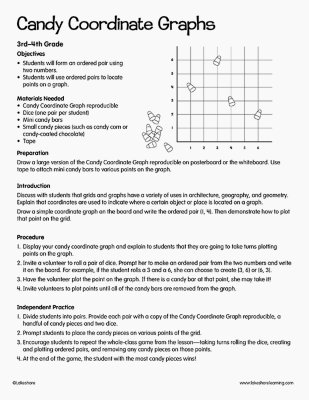Narrow by Grade
- Infant (3)
- Toddler (2)
- Preschool (0)
- Pre-K (2)
- Kindergarten (4)
- 1st (1)
- 2nd (2)
- 3rd (3)
- 4th (4)
- 5th (1)
- 6th & Up (0)
Grade 3rd
Narrow by Age
- 0-18m (0)
- 18-36m (0)
- 3 yrs. (0)
- 4 yrs. (0)
- 5 yrs. (0)
- 6 yrs. (0)
- 7 yrs. (0)
- 8 yrs. (3)
- 9 yrs. (1)
- 10 yrs. (1)
- 11 yrs. & Up (0)
Age
3 results for "giant"
Filters
Clear All
My Winter Acrostic
3rd Grade - 5th Grade
Objectives Reading: Literature Reading and comprehending grade-appropriate literature, including stories, dramas, and poetry Writing Writing an acrostic poem Materials Needed Animal Acrostics by David Hummon or Autumn: An Alphabet Acrostic by Steven Schnur My Winter Acrostic template Winter Acrostic Organizer template Dark-blue construction paper - 9" x 12" Crayons or colored pencils Pencil Chalk or write & wipe marker Chalkboard or write & wipe board Introduction Hold up the book Animal Acrostics by David Hummon or Autumn: An Alphabet Acrostic by Steven Schnur. Then explain that the first letter of each line in an acrostic poem spells out a “topic” word that ties all the lines of the poem together. (It’s helpful to demonstrate the concept on a chalkboard or write & wipe board.) Read a few examples from the book and show students how acrostic poems are arranged on a page. (You may want to reproduce one on the board or a large poster so students can refer to it throughout the lesson.)
View Lesson PlanThe Sea and Me: A Measurement Lesson
3rd Grade
Objective Students will use measurement skills to compare the relative size of sea animals. Materials Needed Is a Blue Whale the Biggest Thing There Is? by Robert E. Wells Adding machine paper roll Tape measure 6 rocks (as paperweights) Butcher paper sheets (large enough for students to lie down on) “The Sea and Me” Record Sheet Rulers Pencils Scissors Preparation: Cut a strip of adding machine paper to match the average length of each sea animal below: Blue Whale: 94 ft. Orca: 32 ft. Bottlenose Dolphin: 12 ft. Label each strip with the name of the animal. (Do not write the length of the animal on the strip.) Introduction Tell students that they are going to learn about measurement and relative size. Then read Is a Blue Whale the Biggest Thing There Is? by Robert E. Wells. After you have finished the book, ask students to share examples of relative size that are given in the book (e.g., a blue whale is big compared to other animals but small compared to Mount Everest). Finally, tell students that they are going to compare the sizes of three sea animals. Then they will compare their own size to the three animals.
View Lesson PlanCandy Coordinate Graphs
3rd Grade
Objectives Students will form an ordered pair using two numbers. Students will use ordered pairs to locate points on a graph. Materials Needed Candy Coordinate Graph reproducible Dice (one pair per student) Mini candy bars Small candy pieces (such as candy corn or candy-coated chocolate) Tape Preparation: Draw a large version of the Candy Coordinate Graph reproducible on posterboard or the whiteboard. Use tape to attach mini candy bars to various points on the graph. Introduction Discuss with students that grids and graphs have a variety of uses in architecture, geography, and geometry. Explain that coordinates are used to indicate where a certain object or place is located on a graph. Draw a simple coordinate graph on the board and write the ordered pair (1, 4). Then demonstrate how to plot that point on the grid.
View Lesson Plan

